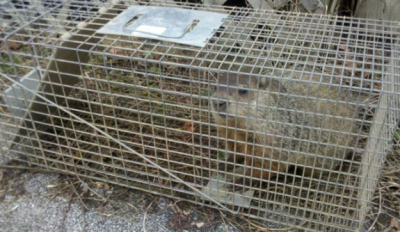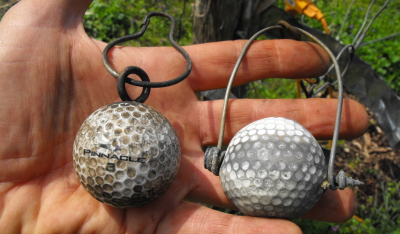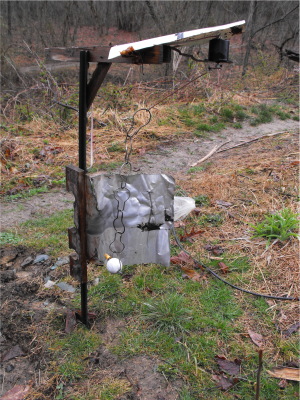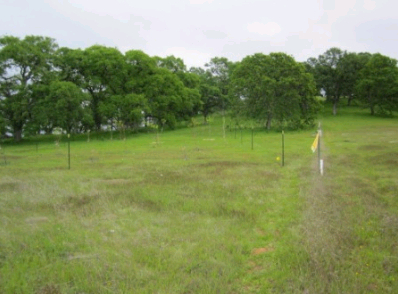
04
My
family is afflicted with a hereditary plague of groundhogs. It
all started with my grandmother, who let the groundhog in her backyard
thrive, despite nibbles in her garden. More recently, my mother
told me the tale of the groundhog in her own Virginia backyard.
(Just so you know, Tobin is her dog, and Maggie and Joey
are my siblings.) Tobin
was out in his yard and suddenly bust into frenzied barking this
afternon--So I went down, and there was a young groundhog on top of his
fence, up near the back edge! When Tobin saw me, he leapt up more
strongly, and almost grabbed its legs!
"Oh!
Oh!" I SCREAMED! "Maggie!"--who heard me and came down. I was so-o
excited I could hardly speak-- "Get the hoe! Get Joey! Turn off the (toaster) oven!! Oh! Oh! Oh!" Good
Maggie! Yes, she looked for the hoe, turned off the oven, e-mailed Joey!
Good Joey! He did turn up (though he'd been working) but to him all we had to do was to take Tobin inside. So he went in Tobin's yard and pulled him out, while I kept dancing around on the other side of the fence! Tobin then pulled away from Maggie's holding the leash and tried to attack the groundhog on my side, but we kept him off, and I went with him into the house. That groundhog did stay on the fence for about an hour, and though I thought of calling someone to shoot it, I called the CritterGitter man, but luckily--since he'd have charged $30.--he was in Kingsport. I'm glad that groundhog got away--I know it lives under the old yellow house on the other side of the block. I don't want it after my garden, but am glad Tobin is better off in the house.
I had given up (again) and planned to put the trap away this evening. I came out at just the right instant, to confuse the beast, already stressed by the appearance of big piles of dirt, to dodging for the wrong hiding place. It's now enjoying its new home out at the lake, and I'm looking forward to enjoying vegetables. 
We're always looking for
innovative ways to keep deer out of the garden, so I thought I'd share
this example from the blogosphere. Freshman
Farmer writes: Last year we tied 80 pound test fishing
line between posts around the
vegetable field and it kept the deer out. They can’t see the fishing
line and it freaks them out.
 Dave
left a comment a couple of weeks ago linking to Transport
Canada's Deer Exclusion Devices and Deterrent Techniques. While we were
researching our own deterrent, I read a similar document
put out by a U.S. state (can't remember which one) noting the best way
to keep deer off airport runways. It sounds like airports are
working hard to find a way to deter deer! Dave
left a comment a couple of weeks ago linking to Transport
Canada's Deer Exclusion Devices and Deterrent Techniques. While we were
researching our own deterrent, I read a similar document
put out by a U.S. state (can't remember which one) noting the best way
to keep deer off airport runways. It sounds like airports are
working hard to find a way to deter deer!I've excerpted a few of Transport Canada's key findings about deer deterrents since they match our experience: "The key to success when using frightening methods and repellents is to use them at the first sign of a deer problem." This has been our experience as well. Once deer find that tasty strawberry plant, it's going to take a lot more than a gentle clanging to chase them away. But if you deter the deer before they find your garden's tasty crops, they will keep out. "The general obstacle to the use of sound for effective animal control is habituation. Many animals adapt to new sounds and learn to ignore them if they are not associated with real danger.... Shooting has been used to frighten or kill deer in agricultural fields.... In these situations, deer are often killed to reinforce the effectiveness of non-lethal deer scaring devices." I have to admit that I back up our deer deterrents with a bit of hunting, and I think it helps. "Gas cannons can be more effective at dispersing deer if the frequency of the explosions is varied and if the cannons are moved every second or third day of use to a different area.... Motion-activated exploders, triggered by passing deer were more effective than exploders that fired at regular intervals. Thus, the exploders only fired when a deer was close by, which made habituation less likely." We're not using cannons (boy was someone desperate!), but Mark is working on making our deer deterrents less regular to get the same effect. Transport Canada notes that ultrasonic noise, reflecting surfaces, and blinking lights don't work. That's been our experience as well. They note that odor and taste-based repellents "are only even partially effective at protecting very small areas." Stay tuned for more gems from Transport Canada later in the week!
The entire article is
interesting reading, and I recommend you start
from the beginning and browse the whole thing. Thanks again
for sharing, Dave! 
Grandpa Brock built a deer
deterrent that works on exactly the same
principle as ours --- many thanks to his
grandson for pointing me in
the direction of the embedded youtube video. If you watch through
to the end, you'll notice that Grandpa Brock adds a pebble to the can
to mix up the sound a bit. We're coming to realize that minor
adjustments like this are enough to keep the deer on their toes and out
of the garden. |
|


